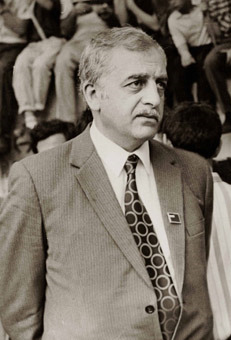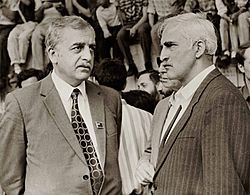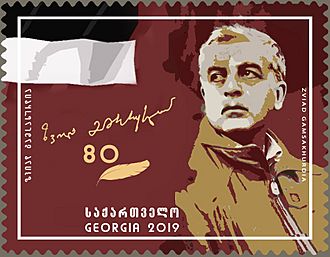Zviad Gamsakhurdia facts for kids
Quick facts for kids
Zviad Gamsakhurdia
|
|
|---|---|
| ზვიად გამსახურდია | |
 |
|
| 1st President of Georgia | |
| In office 14 April 1991 – 6 January 1992 |
|
| Prime Minister | Murman Omanidze (Acting) Besarion Gugushvili |
| Preceded by | Office established |
| Succeeded by | Eduard Shevardnadze (1995) |
| Chairman of the Supreme Council of Georgia | |
| In office 14 November 1990 – 14 April 1991 |
|
| Preceded by | Irakli Abashidze |
| Succeeded by | Himself as the Head of state; Akaki Asatiani as the Chairman of the Parliament of Georgia |
| Personal details | |
| Born | 31 March 1939 Tbilisi, Georgian SSR, Soviet Union |
| Died | 31 December 1993 (aged 54) Dzveli Khibula, Georgia |
| Political party | Round Table—Free Georgia |
| Spouses |
Dali Lolua
(divorced)Manana Archvadze-Gamsakhurdia |
| Signature | |
Zviad Gamsakhurdia (born March 31, 1939 – died December 31, 1993) was a Georgian politician, writer, and scholar. He became the first democratically elected President of Georgia after the Soviet Union broke apart.
Gamsakhurdia was a strong supporter of Georgian nationalism. He was involved in the Soviet dissident movement from a young age. This movement worked against the Soviet government. He helped create groups that spread messages against Soviet rule. Because of his activities, he was arrested and imprisoned several times.
He also co-founded the Georgian Helsinki Group. This group worked to show the world how human rights were being violated in the Soviet Union. Gamsakhurdia led many protests for Georgia's independence. One big protest in 1989 was stopped by the Soviet Army, and he was arrested.
Later, many political groups joined together with Gamsakhurdia. They formed the "Round Table—Free Georgia" group. This group won the 1990 elections against the ruling Communist Party of Georgia. Gamsakhurdia was elected President of Georgia in 1991 with a large number of votes.
However, he faced strong opposition from some groups in Georgia. In late 1991, Gamsakhurdia was overthrown by military leaders. He had to leave Georgia and went to Chechnya. His supporters continued to fight the new government. In 1993, Gamsakhurdia returned to Georgia to try and get back power. His attempt failed, and he died in unclear circumstances at the end of 1993.
After a civil war, Gamsakhurdia's supporters were still treated harshly. However, many Georgians today see him as a great leader. He was later honored by the Georgian government as a National Hero of Georgia. People in Georgia remember him every year on his birthday.
Gamsakhurdia believed strongly in Georgian identity. He wanted to protect Georgians and their culture. He also promoted the idea of unity among the Peoples of the Caucasus against Russian imperialism. He saw Georgians as part of European civilization.
Contents
Becoming a Dissident Leader
Early Years and Activism
Zviad Gamsakhurdia was born in Tbilisi, the capital of Georgia, in 1939. His father, Konstantine Gamsakhurdia, was a very famous Georgian writer. Zviad studied languages and literature. He worked as a translator and literary critic.
In 1955, Gamsakhurdia started a secret youth group called Gorgasliani. This group aimed to share information about human rights problems. He was arrested in 1956 during protests against Soviet policies. He was arrested again in 1958 for sharing anti-communist writings. He was even sent to a mental hospital for six months. This was a way the Soviet government sometimes dealt with political opponents.
Fighting for Human Rights
Gamsakhurdia became more well-known in 1972. He spoke out against corruption in the Georgian Orthodox and Apostolic Church. He was a very devoted member of this church.
In 1973, he helped start the Georgian Action Group for the Defense of Human Rights. In 1974, he became the first Georgian member of Amnesty International. In 1976, he co-founded and led the Georgian Helsinki Group. He also wrote for secret underground newspapers called samizdat. These papers shared news and ideas that the Soviet government did not allow.
Gamsakhurdia also had a successful academic career. He worked at the Institute of Georgian Literature and Tbilisi State University. He wrote many important literary works. He also translated books by famous writers like William Shakespeare and Oscar Wilde.
Even though he was often bothered and arrested, Gamsakhurdia avoided serious punishment for a long time. This was probably because his family was well-known and had connections. But in 1977, the Soviet government started cracking down on human rights activists. Gamsakhurdia and his fellow activist Merab Kostava were arrested on April 7, 1977.
Trial and Release
Gamsakhurdia and Kostava were sentenced to three years in prison camps. They also faced three years of exile for "anti-Soviet activities." Gamsakhurdia's sentence was later changed to two years of exile in Dagestan. Their imprisonment caught international attention.
Gamsakhurdia was released from prison in June 1979. The authorities claimed he had admitted his mistakes and changed his views. A video was even shown on Soviet television. However, his supporters and family said he was forced to say these things by the KGB. Gamsakhurdia later said that his "confession" was a trick. It allowed him to be released and continue his work for Georgia's independence.
Soon after his release, Gamsakhurdia went back to his activist work. He kept writing for underground papers. He also campaigned for Merab Kostava to be released. In 1981, he became a voice for students protesting threats to Georgian culture. He gave a list of "Demands of the Georgian People" to Eduard Shevardnadze, who was a top Communist official at the time. This led to Gamsakhurdia being jailed again.
Steps Towards Independence
When Soviet leader Mikhail Gorbachev started his "glasnost" policy (meaning "openness"), Gamsakhurdia played a big role. He helped organize large protests for independence in Georgia between 1987 and 1990. Merab Kostava joined him after his release in 1987.
In 1988, Gamsakhurdia helped create the Society of Saint Ilia the Righteous. This group became the base for his political movement. A key event was the brutal attack by Soviet forces on a peaceful protest in Tbilisi on April 9, 1989. This event made many people turn against Soviet rule.
Democratic reforms sped up, leading to Georgia's first democratic elections on October 28, 1990. Gamsakhurdia's party joined with other groups to form the "Round Table — Free Georgia" coalition. This group won a big victory. On November 14, 1990, Zviad Gamsakhurdia was elected chairman of the Supreme Council of the Republic of Georgia.
Georgia held a referendum (a public vote) on independence on March 31, 1991. Almost 99% of voters chose independence. The Georgian parliament then declared independence on April 9, 1991. This brought back the independent Georgian state that existed from 1918 to 1921. Gamsakhurdia was elected president in an election on May 26, 1991, with over 86% of the votes.
Gamsakhurdia as President
When Gamsakhurdia became president, Georgia faced many challenges. These included economic problems and difficult relations with the Soviet Union. A big issue was the situation of Georgia's many ethnic minorities. These groups made up 30% of the population.
Before Georgia's independence, there was already tension with minority groups. This led to violence in Abkhazia in 1989. In 1989, violence also broke out in South Ossetian Autonomous Oblast. This was between Georgians who wanted independence and Ossetians who supported the Soviet Union. South Ossetia's local government announced it would separate from Georgia. In response, Georgia's parliament ended South Ossetia's special status in March 1990.
Fighting broke out in the region. By March 1991, 51 people had died, and 25,000 people had to leave their homes. Gamsakhurdia said the Ossetian move was a Russian plan to weaken Georgia. He called the Ossetian separatists "agents of the Kremlin."
Criticism and Opposition
Gamsakhurdia's opponents criticized him for what they saw as "dictatorial behavior." Even before he became president, some people had these concerns. In August 1991, Prime Minister Tengiz Sigua and two other ministers resigned. They accused Gamsakhurdia of being a "demagogue" and "totalitarian." They also complained about the slow pace of economic reforms. Gamsakhurdia said his enemies were trying to betray Georgia.
Gamsakhurdia's reaction to a coup attempt against President Gorbachev in the Soviet Union caused more debate. On August 19, Gamsakhurdia asked Georgians to stay calm. He then asked international leaders to recognize the republics that had declared independence from the Soviet Union.
He also claimed that Gorbachev himself had planned the coup. This idea was rejected by US President George H. W. Bush. There were also reports that Gamsakhurdia had agreed to disarm the Georgian National Guard. Gamsakhurdia denied this, saying he never intended to break up the National Guard. Despite the claims, the coup in Moscow failed. Gamsakhurdia congratulated Russia's President Boris Yeltsin. Georgia avoided violence during the coup. However, Gamsakhurdia's opponents said he was not strong enough in opposing it.
Gamsakhurdia was angry. He accused Moscow of working with his enemies inside Georgia. He told his supporters that "the Kremlin will not prevent us from becoming free." He closed an opposition newspaper for calling for a rebellion. A leader of an opposition group, Giorgi Chanturia, was arrested. A television station was also closed after its employees joined protests against the government.
These actions led to strong criticism both in Georgia and from other countries. A US Congress delegation reported "severe human rights problems" in Gamsakhurdia's government. This was one reason why major countries were slow to recognize Georgia's independence.
The political disagreements turned violent on September 2, 1991. A protest in Tbilisi was broken up by police. The Georgian National Guard also split into two groups: one supporting Gamsakhurdia and one against him. Fighting broke out in Tbilisi in October and November. Paramilitary groups, like the anti-Gamsakhurdia "Mkhedrioni" (meaning "Horsemen"), set up roadblocks around the city.
Overthrow of the President
On December 22, 1991, armed opposition supporters launched a violent attack. They attacked government buildings, including the parliament building where Gamsakhurdia was hiding. Heavy fighting continued in Tbilisi until January 6, 1992. Hundreds of people died, and the city center was badly damaged.
On January 6, Gamsakhurdia and his government escaped. They went to Azerbaijan, but were not allowed to stay. Armenia hosted Gamsakhurdia for a short time. To avoid problems with Georgia, Armenia allowed Gamsakhurdia to go to Chechnya. The Chechen government gave him a safe place to stay.
Some people later claimed that Russian forces helped in the coup against Gamsakhurdia. A Russian newspaper reported that Russian military units helped the armed opposition.
A Military Council made up of Gamsakhurdia's opponents took over the government. They officially removed Gamsakhurdia as president. In March 1992, they appointed Gamsakhurdia's old rival, Eduard Shevardnadze, as chairman. Shevardnadze then ruled Georgia until a new president was elected in 1995.
Life in Exile and Death
After being overthrown, Gamsakhurdia continued to say he was the rightful president of Georgia. Some governments still recognized him as such. He refused to accept that he was no longer president. This was because he had been elected by a huge number of people.
Fighting between Gamsakhurdia's supporters and government forces continued in 1992 and 1993. Gamsakhurdia's supporters sometimes captured government officials. The government responded with raids. In June 1992, Gamsakhurdia's supporters took over the state television center in Tbilisi. They broadcast a message saying the "legitimate government has been reinstated." But they were quickly driven out.
Shevardnadze's government used harsh methods to stop Gamsakhurdia's supporters. Security forces and the pro-government Mkhedrioni militia arrested and harassed many people. Even though Georgia's human rights record was criticized, Shevardnadze's reputation helped Georgia gain international recognition.
In September 1992, government troops went into Abkhazia to find Gamsakhurdia's supporters. But their actions made ethnic relations worse. Later, in September 1993, a full-scale war broke out between Georgian forces and Abkhazian separatists. The government lost this war. Many Georgians were forced to leave Abkhazia.
1993 Civil War
Gamsakhurdia saw a chance to remove Shevardnadze. He returned to Georgia on September 24, 1993. He set up a "government in exile" in the city of Zugdidi in western Georgia. He announced he would continue a "peaceful struggle against an illegal military junta." He gathered support from regions like Samegrelo and Abkhazia. He also built up a strong military force.
After initially asking for new elections, Gamsakhurdia's forces took many weapons left behind by retreating government troops. A civil war started in western Georgia in October 1993. Gamsakhurdia's forces captured several important towns and transportation centers. Government forces were in disarray.
However, Gamsakhurdia's capture of the important Black Sea port of Poti threatened the interests of Russia, Armenia, and Azerbaijan. All three countries then supported Shevardnadze's government. In return, Georgia agreed to join the Commonwealth of Independent States. Russia sent troops to help the Georgian government. On October 20, about 2,000 Russian troops moved to protect Georgian railroads. They also gave weapons to the government forces. The uprising quickly failed, and Zugdidi fell on November 6.
Gamsakhurdia's Death
Zviad Gamsakhurdia died on December 31, 1993. The exact reasons for his death are still unclear and debated. He died in the village of Dzveli Khibula in western Georgia. His body was later re-buried in the village of Jikhashkari.
Years later, a former counter-intelligence head admitted that two special units were looking for Zviad on the interim government's orders. Two members of the President's personal guard also disappeared in December 1993.
Theories About His Death
Some people believe Gamsakhurdia was assassinated. His widow insists he was murdered. There were even claims that a secret laboratory might have been involved in designing a undetectable agent to kill him.
The Georgian Interior Ministry under Shevardnadze's government suggested he was killed by his own supporters. Another idea was that he died after a fight with his former commander, Loti Kobalia.
Gamsakhurdia's death was announced on January 5, 1994. Some people did not believe he had died. But his body was found on February 15, 1994. His remains were first buried in Grozny, Chechnya. In 2007, his grave was found in Grozny. His remains were identified and brought back to Georgia. He was reburied at the Mtatsminda Pantheon in Tbilisi on April 1, 2007. Thousands of Georgians came to pay their respects.
Investigation into His Death
In December 2018, Gamsakhurdia's two sons, Constantine and Tsotne, raised concerns. They worried that the time limit for investigating serious crimes was about to expire. They started a hunger strike.
On December 21, President Salome Zurabishvili supported their request. She called Gamsakhurdia's death a "murder." Parliament then approved a bill to extend the time limit for serious crime investigations from 25 to 30 years. A new investigative group was set up. Tsotne Gamsakhurdia ended his hunger strike, hoping for a new investigation into his father's death.
Personal Life
Gamsakhurdia was married twice. With his first wife, Dali Lolua, he had one son, Konstantine Gamsakhurdia.
His second wife, Manana Archvadze-Gamsakhurdia, became the first First Lady of independent Georgia. They had two sons, Tsotne and Giorgi.
Legacy and Recognition
On January 26, 2004, President Mikheil Saakashvili officially honored Gamsakhurdia. This was done to help heal divisions in Georgian society. Saakashvili praised Gamsakhurdia as a "great statesman and patriot." He also allowed Gamsakhurdia's body to be reburied in Tbilisi. He said it was a "shame" that the former president's grave was in a war zone. Saakashvili also renamed a major road in Tbilisi after Gamsakhurdia. He released 32 of Gamsakhurdia's supporters who had been imprisoned. Many Georgians and human rights groups considered them political prisoners. In 2013, Gamsakhurdia was given the title and Order of National Hero of Georgia.
Gamsakhurdia's supporters continue to share his ideas through various groups. In 1996, the Zviad Gamsakhurdia Society was founded in the Netherlands. It now has members in many European countries.
See also
 In Spanish: Zviad Gamsajurdia para niños
In Spanish: Zviad Gamsajurdia para niños
- List of unsolved deaths
Selected Works
- 20th century American Poetry (a book). Ganatleba, Tbilisi, 1972
- The Man in the Panther's Skin" in English, a book, Metsniereba, Tbilisi, 1984.
- "Goethe's Weltanschauung from the Anthroposophic point of view.", Tsiskari, Tbilisi, No 5, 1985
- Tropology (Image Language) of "The Man in the Panther's Skin", book). Metsniereba, Tbilisi, 1991
- Collected articles and Essays. Khelovneba, Tbilisi, 1991
- Gamsakhurdia: a Product of the Soviet Union. Janice Bohle, University of Missouri, 1997.
- The Spiritual mission of Georgia (1990)
- "Dilemma for Humanity", Nezavisimaia Gazeta, Moscow, May 21, 1992
- "Between deserts" (about the creative works of L. N. Tolstoy), Literaturnaia Gazeta, Moscow, No 15, 1993
- Fables and Tales. Nakaduli, Tbilisi, 1987
- The Betrothal of the Moon (Poems). Merani, Tbilisi, 1989
Links and Literature
- Reports of the International Society for Human Rights (ISHR-IGFM)
- Reports of the British Helsinki Human Rights Group (BHHRG)
- Georgian Media in the 90s: a Step To Liberty
- Country Studies: Georgia — U.S. Library of Congress
- [1] "The Lion in Winter — My Friend Zviad Gamsakhurdia", Todor Todorev, May 2002
- Zviad Gamsakhurdia. "Open Letter to E. Shevardnadze"
- "The Transcaucasian Republics and the Coup", Elizabeth Fuller, August 1991



